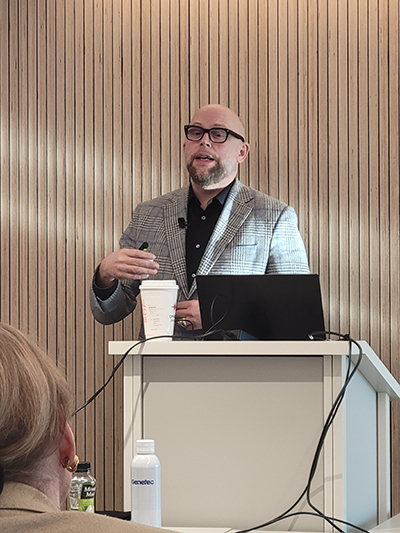Genetec’s Andrew Elvish - Physical security change is “truly seismic” VP of marketing explains physical security’s rapid transition during Genetec’s Global Press Summit

By Cory Harris, Editor
Updated 7:52 AM CST, Fri February 16, 2024

WASHINGTON, D.C.—The physical security industry is constantly evolving, never more so than right now.
In fact, according to Andrew Elvish, Genetec’s VP of marketing, physical security is currently in rapid transition, or as he put it during Genetec’s recent Global Press Summit, “seismic.”
 Elvish kicked off the gathering of international journalists at Genetec’s Experience Center, DCXC, in the nation’s capital with a session titled, “Seismic – Observations on an industry in rapid transition.”
Elvish kicked off the gathering of international journalists at Genetec’s Experience Center, DCXC, in the nation’s capital with a session titled, “Seismic – Observations on an industry in rapid transition.”
His session offered observations on how the physical security market is undergoing a seismic shift, based on the results of a survey Genetec conducted in 2023 and revealed in its “State of Physical Security 2024” report.
Elvish began his discussion by asking the assembled media, “What's driving a lot of our thinking right now, and what's driving the sort of motivations behind changes that are going on in the market?”
He then stated, “I want to talk to you about what I'm calling a seismic shift. You're in a period of rapid transition, a period of transition that you may not have seen in this industry.”
Evolution
Before Elvish dove into the results of the survey, he talked about the evolution of Genetec over the past 10 years – based on global rankings from data collected by Omdia - in emerging as one of the top VMS, access control and automatic license plate recognition (ALPR) providers in the world, the result of what Elvish called “doing business well” by “working with our channel partners in getting products to the end users.”
He noted that Genetec’s evolution as a leading provider over the past decade resulted from the “maturing of an industry and how mindsets are shifting right now,” adding that Genetec’s platform is based on unification, or as he described it, “bringing together the core functions of security into one platform. That idea of the unified platform was so attractive that as people used our product, they wanted to consume more of the product because it just makes things easier to do.”
Elvish cited a quote from Harvard Business Review’s Bill Taylor in summarizing Genetec’s focus on living up to the expectations of its end users and channel partners – “It’s not how well you stack up against what your rivals are already doing, but whether or not you live up to what your customers believe you can and should be doing.”
“This really is where we want to drive our focus. This is where we want to be thinking,” he said. “We want to live up to what our customers, who are our channel partners and their end users, believe we can and should be doing.”
State of Physical Security
Elvish discussed the “State of Physical Security” report, which polled more than 5,500 physical security professionals, divided into two target groups – end users and channel partners.
Key findings showed that cloud adoption in physical security had been gradual but is now accelerating, with the future of most physical security solutions appearing to be a blend of on-premises and cloud-based solutions.
“The real growth in the market is happening with cloud-connected physical security tools,” Elvish noted. “Moving to the cloud is a means to an end, and the end is achieving greater output, greater quality, and greater efficiencies.”
The report noted that 52 percent of channel partners offer cloud-based solutions when customers request it, 39 percent of channel partners lead with cloud-based solutions whenever possible, with 74 percent anticipating an increase in cloud connectivity in the coming year.
“This is a bigger change than going from coaxial cable to Ethernet cable,” Elvish said. “This is a bigger change because it's also a change in business practices. It's a change in how we do business.”
Another key point from the report was that a “concerning” 31 percent of end users indicated that their organization was targeted by cyber criminals in 2023, mostly in the banking and finance industry (46 percent).
Elvish noted, however, that businesses are prioritizing a better cybersecurity strategy in response to these threats, with 42 percent of organizations increasing deployments of cyber tools in their physical security environments in 2023, up from 29 percent in 2022.
He added that “channel partners are taking a lot of action on this front as well, but there's still quite a bit of work to do.”
Security and Safety versus IT
Elvish cited a ‘big difference” in the perspectives of security and safety specialists and information technology (IT) specialists when it comes to cybersecurity.
The report revealed that 61 percent of IT specialists deployed cyber-related tools, compared to 46 percent of security and safety specialists. In addition, 50 percent of IT specialists pointed to cybersecurity vulnerabilities as the top challenge in 2023, compared to 36 percent of security and safety specialists.
Other findings in the differing perspectives showed that 54 percent of IT specialists improved their cyber strategies in 2023, with just 37 percent of security and safety specialists citing cyber improvement last year.
Another telling finding revealed that 46 percent of IT specialists have future plans in place to implement cybersecurity tools, and only 26 percent of security and safety specialists said they have future plans to implement cyber tools.
“We see a massive gulf between those two cohorts,” Elvish said of these findings.
He added that over the past decade, IT departments have taken on greater responsibility for managing physical security systems with the transition to network physical security systems. The report showed that 82 percent of IT respondents said their department had access to their organizations’ physical security data, compared to 47 percent of security and safety respondents.
“The difference is what they're doing in terms of physical security,” Elvish noted. “We're starting to see IT acquiring more physical security than the physical security departments themselves. This is indicative of a growing shift toward the buying power being in the IT group in the security space.”
OpEx (Operating Expense) budgets in 2023 also provided a clear indication of the increased influence of IT in the physical security space. Elvish stated that 61 percent of IT respondents saw their OpEx budgets either flat or increased in 2023, compared to only 48 percent of security and safety respondents.
“The difference between the budgets is telling,” he said. “The money is in IT, and physical security needs to get more serious and get a seat around the table because this market is changing quickly.”
Seismic Change
Elvish summed up his discussion on the rapid transition of the physical security space with a quote by Austrian poet Rainer Maria Rilke – “The future enters into us, in order to transform itself in us, long before it happens.”
“What has been transforming itself in us?” he asked. “It’s a change not just of technology. It's not just the change from analog to IP. And it's not just a change in how we think about our business or how our partners and end users consume the technology, but rather the very nature of what we should expect from the physical security practice, changes happening now, change that will certainly transform our tomorrow, and change that, I believe, is truly seismic.”
Comments